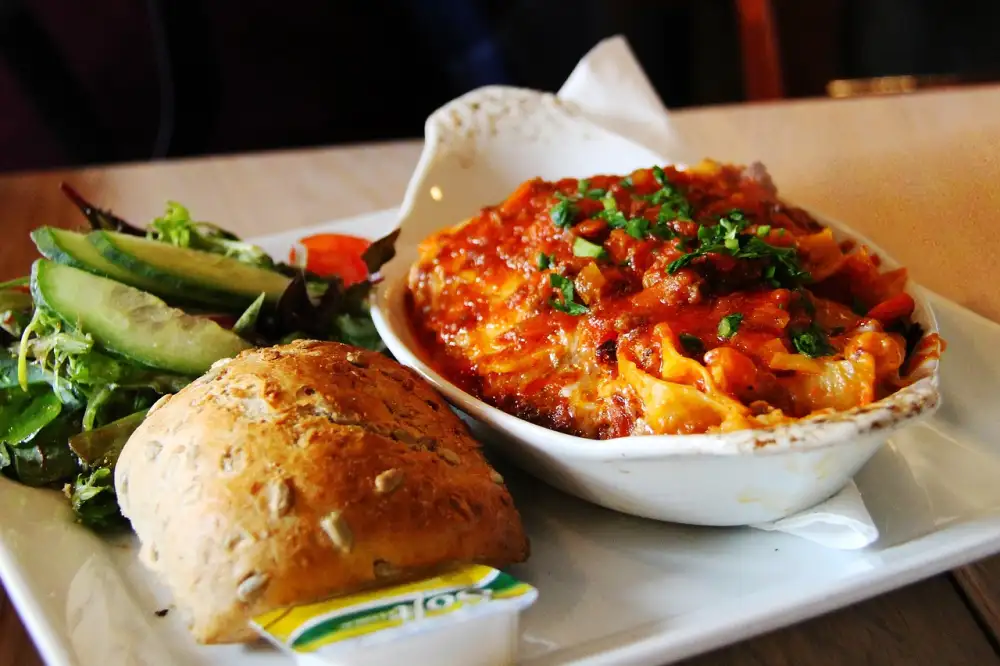Layered Delight: Exploring the Art of Lasagne Layers in Food

- Understanding the Importance of Layering in Lasagna
- Exploring Different Types of Lasagna Layers
- Tips for Creating Perfect Lasagne Layers
- A Step-by-Step Recipe for Delicious Lasagne Layers
- Variations and Creative Ideas for Lasagne Layer Combinations
- Serving and Presentation Suggestions for Lasagne Layers
Lasagne, a classic Italian dish, is a true comfort food that has been enjoyed for centuries. At the heart of this delectable dish lies the art of layering. Each layer adds depth and flavor, creating a harmonious blend of ingredients that is both satisfying and indulgent.
The beauty of lasagne lies in its versatility. From traditional meat-based fillings to vegetarian or seafood options, the layers can be customized to suit any palate. The combination of pasta sheets, rich sauces, and flavorful fillings creates a symphony of tastes that is sure to delight.
In this article, we will delve into the world of lasagne layers and explore their importance in creating a truly exceptional dish. We will also provide tips for achieving perfect layers and share a step-by-step recipe for mouthwatering lasagne. So get ready to embark on a culinary journey as we unravel the secrets behind the art of lasagne layers.
Understanding the Importance of Layering in Lasagna
When it comes to creating a mouthwatering lasagna, the art of layering is crucial. Each layer adds depth and flavor to the dish, resulting in a harmonious blend of textures and tastes. The importance of layering lies in the way it allows the ingredients to meld together, creating a cohesive and delicious final product.
Firstly, layering ensures that each ingredient has its moment to shine. By carefully arranging the different components, such as pasta sheets, meat or vegetable fillings, cheese, and sauce, you can ensure that every bite is packed with flavor. Each layer contributes its own unique taste and texture, making each mouthful a delightful experience.
Secondly, layering helps distribute the flavors evenly throughout the lasagna. As the dish bakes in the oven, the heat penetrates each layer, allowing the flavors to mingle and intensify. This results in a rich and well-balanced taste that permeates every bite.
Furthermore, layering also plays an important role in achieving the desired texture of lasagna. By alternating between layers of pasta sheets and filling ingredients, you create a perfect balance between softness and firmness. The pasta sheets absorb some of the moisture from sauces and fillings while retaining their structure, resulting in a satisfying bite.
Lastly, proper layering enhances visual appeal. A well-layered lasagna showcases its beautiful colors and textures when served on a plate or cut into individual portions. The distinct layers create an inviting presentation that entices diners to savor each component.
In conclusion, understanding the importance of layering in lasagna is key to creating a truly memorable dish. It allows for optimal flavor distribution, texture variation, and visual appeal. So next time you embark on making lasagna at home or in your restaurant kitchen, remember that mastering this art will elevate your culinary skills to new heights.
Exploring Different Types of Lasagna Layers
When it comes to lasagna, the layers are what make this dish truly special. Each layer adds a unique flavor and texture, creating a harmonious blend of ingredients that is simply irresistible. While traditional lasagna typically consists of layers of pasta, meat sauce, and cheese, there are countless variations that allow you to get creative with your layers.
One popular variation is vegetable lasagna, where layers of thinly sliced zucchini or eggplant replace the pasta sheets. This not only adds a healthy twist to the dish but also enhances the flavors of the other ingredients. You can also experiment with different types of cheeses for each layer, such as ricotta, mozzarella, or Parmesan, to create a more complex and indulgent taste.
For seafood lovers, seafood lasagna is a delightful option. Layers of creamy white sauce combined with shrimp, scallops, and crabmeat create a luxurious and decadent dish that is perfect for special occasions. Alternatively, you can try vegetarian lasagna with layers of sautéed mushrooms, spinach, and a variety of cheeses for a hearty and flavorful meal.
Another interesting twist is Mexican-inspired lasagna with layers of tortillas instead of pasta sheets. This fusion dish combines classic Mexican flavors like salsa, black beans, corn, and spicy ground beef or shredded chicken for a bold and vibrant taste experience.
If you're feeling adventurous in the kitchen, you can even experiment with sweet dessert lasagnas. Layers of sweetened mascarpone cheese or whipped cream alternated with fresh fruits like berries or sliced peaches make for an indulgent treat that will satisfy any sweet tooth.
The possibilities are endless when it comes to exploring different types of lasagna layers. Don't be afraid to mix and match ingredients to create your own unique combinations. Whether you prefer classic flavors or want to venture into new culinary territories, experimenting with different types of lasagna layers will surely elevate your cooking skills and impress your guests.
Tips for Creating Perfect Lasagne Layers
Creating perfect lasagne layers requires some attention to detail and a few key tips. Here are some suggestions to help you achieve lasagne layer perfection:
1. Cook your noodles al dente: Overcooked noodles can become mushy when layered in the lasagne. Cook them until they are still slightly firm, as they will continue to cook in the oven.
2. Use a good-quality sauce: A flavorful sauce is essential for delicious lasagne layers. Whether you're using a classic tomato sauce or a creamy béchamel, make sure it's well-seasoned and packed with flavor.
3. Spread a thin layer of sauce on the bottom: This helps prevent the noodles from sticking and adds moisture to the dish.
4. Layer evenly: Spread an even amount of sauce, cheese, and filling between each layer of noodles. This ensures that every bite has a balanced combination of flavors.
5. Don't skimp on cheese: Cheese is one of the highlights of lasagne layers, so be generous with it! Mozzarella, Parmesan, and ricotta are popular choices that add creaminess and richness.
6. Add texture with vegetables or meat: Layering cooked vegetables like spinach or mushrooms adds depth and texture to your lasagne layers. If you prefer meat, consider adding cooked ground beef or sausage for added flavor.
7. Press down gently: After each layer is added, press down gently with a spatula or the back of a spoon to compact the ingredients and create even layers.
8. Let it rest before serving: Once your lasagne is assembled, let it rest for 10-15 minutes before cutting into it. This allows the layers to set and makes it easier to serve without falling apart.
By following these tips, you'll be well on your way to creating perfect lasagne layers that are both visually appealing and incredibly tasty!
A Step-by-Step Recipe for Delicious Lasagne Layers
1. Start by preparing the sauce: In a large pan, heat olive oil and sauté finely chopped onions and garlic until golden brown. Add ground beef and cook until browned. Stir in tomato paste, crushed tomatoes, dried herbs, salt, and pepper. Simmer for 20 minutes.
2. While the sauce is simmering, prepare the béchamel sauce: Melt butter in a saucepan over medium heat. Whisk in flour until smooth. Gradually add milk while whisking continuously to avoid lumps. Cook until thickened, then remove from heat and stir in grated Parmesan cheese.
3. Preheat the oven to 375°F (190°C). In a greased baking dish, spread a thin layer of meat sauce on the bottom.
4. Place lasagna noodles on top of the sauce in an even layer, slightly overlapping each other.
5. Spread a layer of meat sauce over the noodles, followed by a layer of béchamel sauce.
6. Repeat this process with another layer of noodles, meat sauce, and béchamel sauce until all ingredients are used up or desired thickness is achieved.
7. Finish with a final layer of noodles topped with béchamel sauce and sprinkle with grated mozzarella cheese.
8. Cover the dish with aluminum foil and bake for 30 minutes. Remove the foil and bake for an additional 15 minutes or until the top is golden brown and bubbling.
9. Allow lasagne to cool for a few minutes before serving to allow it to set properly.
10. Garnish with fresh basil leaves or parsley before serving for added freshness and flavor.
Enjoy your homemade lasagne layers!
Variations and Creative Ideas for Lasagne Layer Combinations
While the classic lasagne layers consist of pasta, meat sauce, and cheese, there are endless possibilities for creative combinations. Here are a few ideas to inspire you:
1. Vegetarian Delight: Replace the meat sauce with a medley of sautéed vegetables like zucchini, bell peppers, and mushrooms. Add layers of creamy ricotta cheese and fresh spinach for an extra burst of flavor.
2. Seafood Sensation: Swap out the traditional meat sauce with a rich seafood marinara sauce made with shrimp, scallops, and chunks of white fish. Layer it between lasagne sheets along with a creamy béchamel sauce and sprinkle grated Parmesan on top.
3. Mexican Twist: Give your lasagne layers a spicy kick by incorporating Mexican flavors. Use salsa instead of tomato sauce, add seasoned ground beef or shredded chicken as the filling, and layer it with tortillas instead of pasta sheets. Top it off with melted cheddar cheese and garnish with fresh cilantro.
4. Mediterranean Fusion: Combine Italian and Greek influences by layering lasagne sheets with a mixture of lamb ragu, feta cheese, and roasted eggplant slices. Drizzle some tzatziki sauce over each layer for a tangy finish.
5. Breakfast Lasagne: Who says lasagne is only for dinner? Create a breakfast version by using scrambled eggs as one layer along with crispy bacon or sausage crumbles. Add in some diced tomatoes, sautéed onions, and shredded cheddar cheese for an irresistible morning treat.
Remember, the key to successful variations lies in balancing flavors and textures while maintaining the integrity of the dish. Don't be afraid to experiment and let your creativity shine through!
Serving and Presentation Suggestions for Lasagne Layers
When it comes to serving and presenting your lasagne layers, there are a few key suggestions to keep in mind. First, make sure to let the lasagne rest for a few minutes after removing it from the oven. This will allow the layers to set and make it easier to cut into neat portions.
To enhance the visual appeal of your dish, consider garnishing with fresh herbs like basil or parsley. These vibrant greens will not only add a pop of color but also bring a touch of freshness to each bite.
Another idea is to sprinkle some grated Parmesan cheese on top of the lasagne layers before serving. The cheese will melt slightly and create a beautiful golden crust that adds both texture and flavor.
For an elegant touch, you can also drizzle some extra virgin olive oil over the lasagne layers just before serving. This will give the dish a glossy sheen and enhance its overall richness.
When plating, use a spatula or a wide flat spoon to carefully lift each portion onto individual plates. Try to maintain the integrity of the layers as much as possible for an impressive presentation.
Finally, serve your lasagne layers with a side salad or garlic bread for a complete meal. The freshness of the salad or the warm crunchiness of garlic bread will complement the rich flavors of the lasagne layers perfectly.
Remember, presentation is key when it comes to showcasing your culinary masterpiece. By following these serving and presentation suggestions, you'll be able to impress your guests with not only delicious but also visually stunning lasagne layers.
In conclusion, mastering the art of lasagne layers is a true culinary achievement. The layers in lasagna not only add depth and texture to the dish but also enhance the overall flavor profile. By understanding the importance of layering and experimenting with different types of ingredients, you can create a lasagna that is truly a work of art.
Remember to follow the tips for creating perfect lasagne layers, such as pre-cooking the noodles, using a generous amount of sauce, and evenly distributing the fillings. These techniques will ensure that each bite is packed with deliciousness.
Don't be afraid to get creative with your lasagne layer combinations. From classic meat and cheese to vegetarian or seafood options, there are endless possibilities to explore. Add some fresh herbs or spices for an extra burst of flavor.
When serving your lasagne layers, consider presentation suggestions such as garnishing with fresh basil leaves or sprinkling grated Parmesan on top. Pair it with a side salad or garlic bread for a complete meal.
In conclusion, mastering the art of lasagne layers requires patience and practice. But once you have perfected this skill, your lasagna will become a true expression of love through food. So go ahead and unleash your creativity in the kitchen – it's time to create layered delights that will impress everyone at your table!
Published: 01. 12. 2023
Category: Food



